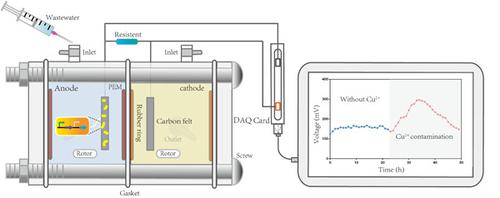当前位置:
X-MOL 学术
›
Biotechnol. Bioeng.
›
论文详情
Our official English website, www.x-mol.net, welcomes your
feedback! (Note: you will need to create a separate account there.)
A copper-specific microbial fuel cell biosensor based on riboflavin biosynthesis of engineered Escherichia coli.
Biotechnology and Bioengineering ( IF 3.5 ) Pub Date : 2020-09-11 , DOI: 10.1002/bit.27563 Tuoyu Zhou 1 , Rong Li 1, 2 , Shuting Zhang 1 , Shuai Zhao 1, 2 , Monika Sharma 1 , Saurabh Kulshrestha 3 , Aman Khan 1 , Apurva Kakade 2 , Huawen Han 1 , Yongyan Niu 2 , Xiangkai Li 1
Biotechnology and Bioengineering ( IF 3.5 ) Pub Date : 2020-09-11 , DOI: 10.1002/bit.27563 Tuoyu Zhou 1 , Rong Li 1, 2 , Shuting Zhang 1 , Shuai Zhao 1, 2 , Monika Sharma 1 , Saurabh Kulshrestha 3 , Aman Khan 1 , Apurva Kakade 2 , Huawen Han 1 , Yongyan Niu 2 , Xiangkai Li 1
Affiliation

|
Copper pollution poses a serious threat to the aquatic environment; however, in situ analytical methods for copper monitoring are still scarce. In the current study, Escherichia coli Rosetta was genetically modified to express OprF and ribB with promoter Pt7 and PcusC, respectively, which could synthesize porin and senses Cu2+ to produce riboflavin. The cell membrane permeability of this engineered strain was increased and its riboflavin production (1.45–3.56 μM) was positively correlated to Cu2+ (0–0.5 mM). The biosynthetic strain was then employed in microbial fuel cell (MFC) based biosensor. Under optimal operating parameters of pH 7.1 and 37°C, the maximum voltage (248, 295, 333, 352, and 407 mV) of the constructed MFC biosensor showed a linear correlation with Cu2+ concentration (0.1, 0.2, 0.3, 0.4, 0.5 mM, respectively; R2 = 0.977). The continuous mode testing demonstrated that the MFC biosensor specifically senses Cu2+ with calculated detection limit of 28 μM, which conforms to the common Cu2+ safety standard (32 μM). The results obtained with the developed biosensor system were consistent with the existing analytical methods such as colorimetry, flame atomic absorption spectrometry, and inductively coupled plasma optical emission spectrometry. In conclusion, this MFC‐based biosensor overcomes the signal conversion and transmission problems of conventional approaches, providing a fast and economic analytical alternative for in situ monitoring of Cu2+ in water.
中文翻译:

基于工程大肠杆菌核黄素生物合成的铜特异性微生物燃料电池生物传感器。
铜污染对水生环境构成严重威胁;然而,用于铜监测的原位分析方法仍然很少。本研究对大肠杆菌Rosetta 进行基因改造,分别表达OprF和ribB,启动子为 P t7和 P cusC,可合成孔蛋白并感知 Cu 2+产生核黄素。该工程菌株的细胞膜通透性增加,其核黄素产量 (1.45–3.56 μM) 与 Cu 2+呈正相关(0–0.5 毫米)。然后将生物合成菌株用于基于微生物燃料电池 (MFC) 的生物传感器。在pH 7.1和37°C的最佳操作参数下,构建的MFC生物传感器的最大电压(248、295、333、352和407 mV)与Cu 2+浓度(0.1、0.2、0.3、0.4)呈线性相关。,分别为 0.5 mM;R 2 = 0.977)。连续模式测试表明,MFC 生物传感器特异性感应 Cu 2+,计算检测限为 28 μM,符合常见的 Cu 2+安全标准 (32 μM)。用开发的生物传感器系统获得的结果与现有的分析方法如比色法、火焰原子吸收光谱法和电感耦合等离子体发射光谱法一致。总之,这种基于 MFC 的生物传感器克服了传统方法的信号转换和传输问题,为水中Cu 2+ 的原位监测提供了一种快速且经济的分析替代方案。
更新日期:2020-09-11
中文翻译:

基于工程大肠杆菌核黄素生物合成的铜特异性微生物燃料电池生物传感器。
铜污染对水生环境构成严重威胁;然而,用于铜监测的原位分析方法仍然很少。本研究对大肠杆菌Rosetta 进行基因改造,分别表达OprF和ribB,启动子为 P t7和 P cusC,可合成孔蛋白并感知 Cu 2+产生核黄素。该工程菌株的细胞膜通透性增加,其核黄素产量 (1.45–3.56 μM) 与 Cu 2+呈正相关(0–0.5 毫米)。然后将生物合成菌株用于基于微生物燃料电池 (MFC) 的生物传感器。在pH 7.1和37°C的最佳操作参数下,构建的MFC生物传感器的最大电压(248、295、333、352和407 mV)与Cu 2+浓度(0.1、0.2、0.3、0.4)呈线性相关。,分别为 0.5 mM;R 2 = 0.977)。连续模式测试表明,MFC 生物传感器特异性感应 Cu 2+,计算检测限为 28 μM,符合常见的 Cu 2+安全标准 (32 μM)。用开发的生物传感器系统获得的结果与现有的分析方法如比色法、火焰原子吸收光谱法和电感耦合等离子体发射光谱法一致。总之,这种基于 MFC 的生物传感器克服了传统方法的信号转换和传输问题,为水中Cu 2+ 的原位监测提供了一种快速且经济的分析替代方案。











































 京公网安备 11010802027423号
京公网安备 11010802027423号